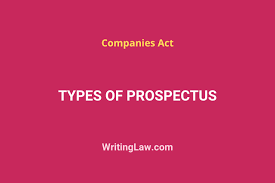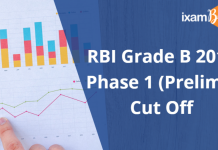This article discusses Prospectus and types. With PFRDA GRADE A 2022 mains and SEBI GRADE A 2023 exam in line, this article will give you an overall understanding of Prospectus with a detailed explanation. Also, this article will give a layman’s understanding to someone who is unfamiliar with the term “Prospectus”.
So before learning about types of Prospectus, let us know what a Prospectus is.
The prospectus is a legal document, which outlines the company’s financial securities for sale to investors. According to the companies act 2013, there are four types of prospectus, abridged prospectus, deemed prospectus, red herring prospectus, and shelf prospectus.
The prospectus can help investors make more informed investment decisions because it contains a host of relevant information about the investment or security. In areas other than investing, a prospectus is a printed document that advertises or describes an offering such as a school, commercial enterprise, forthcoming book, etc. All forms of prospectus exist to attract or inform clients, members, buyers, or investors.

Understanding Prospectus:
As per the Companies Act, 2013, a prospectus can include information such as an advertisement, circular, or notice among other legal documents inviting the public to the offering. Also, the prospectus should be issued only for the purchase of a company’s securities.
In order for a document to be considered a prospectus, it should act as an invitation for the public to purchase stocks/shares, debentures, or other instruments. Also, the prospectus should be issued by the company or an institution on behalf of the company and made solely for the public.
In case a private company wishes to convert to a public company, it is required to either issue a prospectus or file a statement in lieu of a prospectus of which the provisions are mentioned under Section 70 of the Companies Act, 2013
Essentials for a document to be called a Prospectus:
For any document to be considered a prospectus, it should satisfy two conditions. The document should invite the subscription to public share or debentures, or it should invite deposits. Such an invitation should be made to the public. The invitation should be made by the company or on behalf company. The invitation should relate to shares, debentures, or other instruments.
The Relevance of the Prospectus
Below is a few reasons why reading a prospectus is essential before investing.
You get to know more about the company: It is always wise to know all about where you put your money. This is especially true when investing in a company’s securities. Not only this can give you a better idea about the potential of the securities and the company itself, but it can also help you measure how much investing in the company is in alignment with your investment horizon.
You get to know more about the securities: There are various securities that a company can offer to the public. This may include stocks, bonds, or even other debt instruments. Going through the prospectus can tell you more about the securities they are trying to sell you. Understanding this can help you make better investment decisions.
For instance, if you are reading a prospectus to find out more about a bond that a company is offering, you can learn about its price, type, face value, coupon rate, etc. This information can help you do your calculations before investing, making planning much easier.
You get to know why they are raising money: There is no business that doesn’t aspire to growth. Every business owner will keep trying to expand their clientele so as not to become stagnate in a fast-growing economy. That means there will be plenty of reasons for companies to raise capital, but it is wise to check why they are raising the money before deciding to invest. This can help you understand if the company’s growth plans align with your risk appetite. For instance, if a company is raising money for an aggressive growth move, you might be better off investing in them if your investment choices are conservative.
Prospectus and its Contents:
The prospectus contents are specified in the Companies Act. The prospectus must touch on the following content points:
- Details of the company, such as name, registered office address, and objects
- Details of signatories to the Memorandum and their shareholding particulars
- Details of the directors
- Details of shares offered and the class of the issue as well as voting rights
- Minimum subscription amount
- The amount payable on application, on the allotment, and on further calls
- Underwriters of issue
- Auditors of the company
- Audited reports regarded the profit and losses of the company
Different types of prospectus

As mentioned above, a prospectus is a legal document as well, and the same is submitted to the Securities and Exchanges Board of India (SEBI). There are different stages that a prospectus will go through before SEBI approves one. The first stage is often the filing of a preliminary prospectus. As the name suggests, this document may only the preliminary data related to the offering. Investors can use this to gain early information about the investment opportunity to simplify the planning part. Once that is approved, the company may file a final prospectus, which SEBI will inspect.
Now, there are different types of a prospectus that companies file, according to what security they are planning to issue. Below are some of the kinds of prospectus filings.
Red herring prospectus
Thanks to the kind of demand that the IPO market sees these days, the red herring prospectus has become a known name among many investors. For those who don’t know, a red herring prospectus is a document filed to SEBI before an IPO. During an IPO, a private company becomes public, and a lot of information has to be then disclosed to the public. Companies use a red herring prospectus to publicize this information. The document thus will contain their financials, performance numbers, goals, risks, etc., making it an ideal record for investors to dig deep and find the potential and risk in investing in the particular company.
Shelf Prospectus
A shelf prospectus is filed when a company intends to issue bonds. Bonds are a way for companies to borrow money to raise capital from the public. Unlike lending from a bank, issuing bonds can be a more affordable option. At the same time, as far as investors are concerned, it is an opportunity to get returns through a less risky investment option.
Reading the prospectus before investing in bonds will help you better understand the same. In addition, there are important numbers such as coupon rate, face value, tenure, etc., that you should look at before investing in a bond, and all this information is available in a shelf prospectus. In the case of a shelf prospectus though, the company will not have to file another one to reissue bonds. In fact, a company can issue bonds up to four times once they issue a prospectus.
Abridged prospectus
It is a type of prospectus that contains the list of all the prospectus and offers that the company has completed. This is for investors like you to understand more about the company and use it for research in decisions related to investment in the company.
Deemed prospectus
Under the implication of law, any document from the company that is meant to sell shares is considered a prospectus. Deemed prospectus becomes important when a company intends to bypass the SEBI laws and issue securities through an intermediary. Here, whenever the company issues securities, even when it is done through a merchant bank or a broker, the company has to issue a document of an offer for sale. This document is called a deemed prospectus. This way, the sale of securities is marked, and investors’ rights are protected even when the company is trying to sell its stocks through intermediaries.
CONCLUSION
A prospectus is basically a formal and legal document issued by a body corporate that acts for inviting offers from the public for subscription or purchase of any securities. Every public company is entitled to issue a prospectus for its shares or debentures. But, the same is not required for a private company.
Hope this article has provided you with a thorough understanding of Prospectus and the types of Prospectus which will be helpful in your future exams.
References: Clear-Tax, Edelweiss,IPleaders and Tavagapedia
To help you prepare 50% faster for competitive exams, ixamBee provides free Mock Test Series for all the Current Affairs in English and Current Affairs in Hindi in the BeePedia capsules for GA Preparation. You can also get the latest updates for Bank PO, Bank Clerk, SSC, RBI NABARD, and Other Government Jobs.












